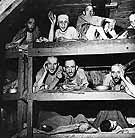 Liberation of the Camps
Liberation of the Camps
On V-E Day, May 8, 1945, men and women danced in the streets of American cities to celebrate the Allies' victory over Nazi Germany. An ocean and a continent away, a more somber victory ceremony took place at Mauthausen. This Nazi concentration camp stood about 12 miles southeast of the Austrian city of Linz, Adolf Hitler's hometown as a teenager--a place, he wrote in Mein Kampf, where his "happiest days" had been spent. There were no "happiest days" at Mauthausen. Established in May 1938, this especially harsh camp was dis-tinctive for the brutal work and sadism associated with its stone quarry. During the war years, Mauthausen and its more than 60 subcamps--Gusen, Gunskirchen, and Ebensee among them--became an industrial empire controlled by the SS. Of the 199,404 prisoners who passed through the camp at Mauthausen, about 119,000 perished, including 38,120 Jews. Soviet troops liberated Majdanek and Auschwitz, death camps on Polish soil, during July 1944 and January 1945, respectively. In the West, units of the U.S. Army freed Buchenwald (pictured) and Dachau, concentration camps in Germany, on April 11 and April 29, 1945, while the British and Canadians reached Bergen-Belsen, Germany, on April 15. At every camp, the liberators found carnage so vast that even battle-scarred veterans were shocked by what they saw. Members of the U.S. Army's 71st Infantry and 11th Armored divisions discovered some of the worst horrors. The 71st liberated Gunskirchen, a Mauthausen satellite, on May 5. The 11th took the city of Linz and freed the Gusen concentration camp on May 5. Its tanks reached the Mauthausen camp itself at 11:30 a.m. on May 5, about 50 hours before Nazi Germany surrendered unconditionally. Captain J. D. Pletcher particularly remembered the odor when he entered Gunskirchen. "The smell," he said, "nauseated many of the Americans who went there. It was a smell I'll never forget, completely different from anything I've ever encountered. It could almost be seen and hung over the camp like a fog of death." Mauthausen and its satellite camps, he said, were places of "foul bodily odors, smoldering trash fires," and "mud mixed with feces and urine." Liberation could not prevent former prisoners from death. For days, dehydration, starvation, disease, and exhaustion continued to take their toll. Liberation came late for Mauthausen and its subcamps--much too late for the vast majority of their defenseless victims--but those places were not the last Holocaust sites to be set free. Not until May 9 did Soviet troops reach the Theresienstadt, Czechoslovakia, camp/ghetto, where they found 19,000 prisoners alive. Polish and Soviet units freed the camp at Stutthof, Poland, on the 8th. Even after Nazi Germany's surrender, a fog of death continued to hang over the liberated camps, as it does at those sites to this day.
Photo: AP / Wide World Photos
|
